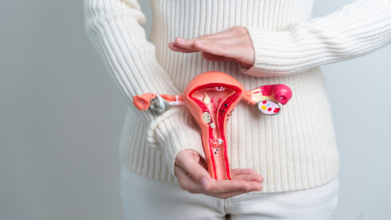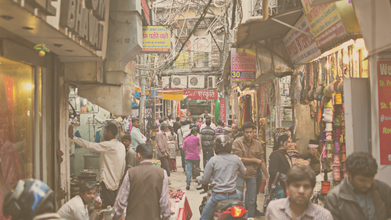- Health Conditions A-Z
- Health & Wellness
- Nutrition
- Fitness
- Health News
- Ayurveda
- Videos
- Medicine A-Z
- Parenting
- Web Stories
A Woman Finally Gets Her 18.5 Kg Fibroid Uterus Removed After 6 Years, Doctor Say She Was Carrying The Weight Of 5 New Born Babies

Credits: Canva
A 56-year-old Delhi woman, who endured nearly six years of severe discomfort and restricted mobility due to a massive fibroid uterus has finally made a recovery after doctors removed the growth. The tumor weighed 18.5 kilograms, which, suggest doctors is roughly equal to five newborn babies.
Years Of Suffering Before The Surgery
The woman first learned of her fibroid uterus during the COVID-19 pandemic. What began as a manageable condition gradually worsened as one of the fibroids grew to an extraordinary size. It expanded in her abdomen and had put constant pressure on surrounding organs. Despite the physical limitations, she delayed surgery for years, fearing the risks associated with the procedure.
Her symptoms slowly became harder to ignore. Everyday activities became exhausting, mobility was restricted, and she experienced persistent discomfort from the sheer size of the mass. Internally, the fibroid pressed on the bladder, intestines, and ureters, although these organs remained functional because the growth progressed slowly, explained Dr Dinesh Kansal, Senior Director and Head, Obstetrics & Gynaecology and Laparoscopic Surgery, Obstetrics & Gynaecology, BLK Max Super Speciality Hospital.
Why the Surgery Was Delayed
Dr Kansal explains that fibroids are generally benign growths in the uterus that often develop gradually, which can make women underestimate their impact.
In this case, the patient postponed treatment partly due to the uncertainty during the pandemic, but also because of the perceived danger of surgery. Over time, the fibroid’s size and the complexity of removing it increased significantly, making the operation far more challenging.
Medical experts stress that delays in addressing such conditions can complicate treatment. Large fibroids can distort internal anatomy, create extensive scar tissue, and place pressure on vital organs, all of which raise the surgical risks.
A High-Risk Procedure
When the woman finally agreed to surgery, her case presented unusual challenges. “This patient had a massive tumor in her uterus. It was more complex and larger than we anticipated from her pre-surgical scans," says Dr Kansal. The fibroid was so large that it had displaced and adhered to nearby organs. She also had internal scarring from earlier operations, adding to the complexity. Removing the mass required careful pre-operative planning and real-time adjustments during the operation.
The surgery lasted about five hours, involving a multidisciplinary team that included specialists from gynecology, urology, anesthesiology, and critical care. The patient’s weight dropped from 69 kilograms before surgery to 51.5 kilograms afterward, a change largely due to the removal of the fibroid and related tissue.
Dr Supriya Mahipal, Associate Consultant, Obstetrics & Gynaecology at BLK-Max Super Speciality Hospital said, "This case demanded not only technical skill but constant intraoperative judgment."
Despite the challenges, the procedure was completed successfully. She was discharged on the fourth day post-surgery and has since returned to an active lifestyle.
Understanding Uterus Fibroids
Uterine fibroids, also called leiomyomas, are non-cancerous tumors that grow in or on the walls of the uterus. They are common in women of reproductive age, though they can occur later in life.
Many fibroids are small and asymptomatic, but some can grow large enough to cause abdominal swelling, pelvic pain, heavy menstrual bleeding, frequent urination, or constipation.
Doctors note that fibroids may develop slowly over years, which can make symptoms easy to dismiss. However, early diagnosis and treatment are important to prevent complications. Large fibroids not only complicate surgery but can also lead to anemia, fertility issues, and damage to surrounding organs.
Medical professionals advise women to seek evaluation for persistent abdominal swelling, unexplained weight changes, or ongoing pelvic discomfort. Timely intervention can mean simpler procedures, fewer risks, and better outcomes.
Ask These 3 Questions To Your GP To Avoid Being Misdiagnosed, According To Doctor

(Credit-Canva)
It is not uncommon for women’s health concerns to be overlooked even by professionals. Often chalking up their health issues as, ‘common women ailments’, many healthcare professionals, miss the core reason for women’s symptoms. In a recent video, Dr Karan Rajan, an NHS Surgeon, shared a video, explaining how often, even signs of chronic illnesses can get overlooked as just ‘anxiety’.
So, is there no way a person can ensure they have the right diagnosis? In the video Dr Karan listed a few ways one can ensure they have the right diagnosis, from asking the right questions and how to proficiently communicate your symptoms to the doctor.
What Questions Should You Ask Your Doctor?
If your doctor told you that your health problems are "just anxiety," remember that you have the right to push for a more thorough checkup. One should ask the right questions as it is their health on the line. Being ready shows you're serious and ensures your doctor looks into your condition properly.
Dr. Karan explains that when talking to your doctor, you should ask questions that make them explain why they settled on an anxiety diagnosis. This shifts the focus back to the doctor, requiring them to justify their medical opinion. Here are the key questions you should use.
"What tests have been done to rule out other causes of my symptoms?"
This question is powerful because it makes the doctor list exactly what they have investigated. It clarifies the boundaries of the investigation. If the doctor hasn't run many tests, you know there's more ground to cover.
"Can you explain why you think this is anxiety and not a physical medical condition?"
Don't accept "your blood work is fine" as the only answer. That's often not enough. Many serious health conditions don't show up on a routine blood test. You want a detailed explanation of their thinking, not just a quick dismissal.
"Have we ruled out other conditions that can look exactly like anxiety?"
It's surprising how many physical illnesses have symptoms that are identical to anxiety. Dr Karan explains how thyroid problems like hypothyroidism, issues with your nervous system like dysautonomia, or even an immune disorder like mast cell activation syndrome, can all cause symptoms like a racing heart, dizziness, or panic. You want to be sure these possibilities have been considered.
Is It Anxiety Or A Health Condition?
If your doctor only suggests things like talk therapy and certain medications (like SSRIs), be prepared to ask for more. You need to know if they're looking at the big picture.
Dr Karan suggests that you should ask them: "What treatment plan would you suggest that goes beyond just treating the anxiety itself?"
If their only answer is medication and counseling, it's fair to ask what other medical routes or specialists can be explored to find the root cause of your symptoms.
How Should You Describe Your Symptoms?
When describing your symptoms, you need to be precise and give the doctor hard data. This makes it much harder for them to brush off your concerns as simple stress. Dr Karan gives an example, instead of just saying, "I get dizzy a lot," get into the details:
"I get dizzy when I stand up, especially in the morning. It's worse after eating or after I’ve been sitting for a long period of time."
This kind of specific detail is very important. Symptoms that happen when you stand up and improve when you lie down could point to a physical problem like Postural Orthostatic Tachycardia Syndrome (POTS), not just everyday anxiety.
The clearer and more factual you are, the less likely they are to dismiss your condition as just "generalized stress." Dr. Rajan emphasizes that "data talks." Start keeping a symptom diary right away! It's an essential tool for tracking your condition every day. In your log, record:
The exact time symptoms happened.
What you ate or drank beforehand.
What made the symptoms better or worse.
Look for patterns. Does the dizziness only happen after you stand up? Do your symptoms worsen after a certain meal, or around your sleep schedule, or with hormonal changes? Bringing this detailed log, to your appointment makes it much, much more difficult for any doctor to doubt or dismiss your concerns.
Think You’re Safe Indoors? Study Says Delhi’s Winter Pollution Follows You Home

Credits: Canva
With Delhi winters coming in, the spell of late smog is most likely to stay not just outside the homes, but it could in fact, follow you inside your homes. A study by the University of Delhi's Satyawati College, Jamia Millia Islamia, and US's South Dakota University, reveal that bacterial levels were recorded to be 10 fold higher than the World Health Organization (WHO) recommended safety limits.
Studies have also found that air inside the city homes have 12 times more fungal spokes than the WHO safety limits. They can cause skin allergies, respiratory issues, and anxiety. As per a 2021 study by the Energy Policy Institute at the University of Chicago (EPIC India), PM 2.5 levels for low-income and high-income households in Delhi were high during the winters. The concentrations reported 23 and 29 times higher than the WHO safe limits, respectively. These findings also suggested that high-income households were 13 times more likely to own air purifiers than low-income households.
In Delhi, No One Gets To Breathe
Dr Kenneth Lee, who was the lead author of the study said, "In Delhi, the bottom line is - whether someone is rich or poor, no one gets to breathe clean air."
Lee further adds, "It’s a complex vicious cycle. When you do not know about the pollution levels inside your homes, you do not worry about it, and hence you are less likely to take corrective actions. Only with increased awareness, demand for clean air may gain momentum.”
The study also found that indoor PM2.5 levels were higher than the value reported by the nearest government monitor. The PM2.5 levels spiked in the mornings and evenings when households were most likely to be cooking.
The recent study published in Frontiers in Public Health 2025 notes that long term exposure to high fungal and bacterial concentration make indoor air in several parts of Delhi as harmful as the smog outside. The study also noted that most fungal particles were smaller than 2.5 microns, this is why they can easily penetrate through your bloodstreams.
The study revealed a distinct seasonal trend in indoor air quality across Delhi. Fungal levels rose steadily from winter, peaking at around 6,050 CFU per cubic metre between September and November, just before the city’s infamous smog season. Bacterial concentrations, meanwhile, climbed from winter to summer, reaching their highest levels in August before tapering off in the fall.
Health complaints among residents were widespread: 33% reported frequent headaches, 23% experienced burning or irritated eyes, 22% suffered persistent coughing or breathlessness, and 18% struggled with sneezing and allergic rhinitis. Another 15% reported skin irritation and itching.
Who Are At Most Risk Of Indoor Pollution?
The study highlighted that children and young adults were particularly vulnerable, about 28% of children under 12 and 25% of young adults (18–30 years) experienced breathing difficulties, coughing, or allergy-related symptoms. Researchers attributed children’s higher susceptibility to developing lungs, increased physical activity, and longer indoor exposure.
Women also reported more eye and skin problems, making up nearly 60% of dermatological and eye irritation cases, likely due to spending more time indoors.
Conducted over a year in North Delhi, the study, “Microbial Indoor Air Quality Assessment and Health Correlations in Densely Populated Urban Areas of Delhi, India”, found that fungal and bacterial levels inside homes were several times higher than WHO’s safe limits, underscoring that Delhi’s pollution crisis extends well beyond outdoor air.
Fact Check: Does Moon Really Affect Your Sleep And Mental Health? Here's What A Neurologist Says

Credits: Canva
You must have heard many people saying that moon disrupts your sleep cycle, and mental health. But, is there really any truth in that? Neurologist Joanna Fong-Isariawongse, who specializes in sleep medicine and how sleep affects brain writes for Scient Alert that yes, the moon affects sleep, however, its impact on mental health could be "much less certain".
The conventional belief is that moon bears an impact on people's mood and behavior, in fact, the term 'lunacy', comes from the word 'luna', which is Latin for Moon.
How Does Moon Impact Your Sleep?
There are studies, notes Joanna, that show that people sleep differently in the days that lead up to full moon. This is when the moon shines brightest. As per a 2013 study, titled 'Evidence that the Lunar Cycle Influences Human Sleep', notes that people sleep 20 minutes less, take longer to fall asleep and another 2014 study published in journal Sleep Medicine show that they even spend less time in deep, restorative sleep.
Another 2021 study, published in the journal Neurophysiology, people across different cultures tend to go to bed later and sleep for shorter periods in the nights before a full moon.
Why does this happen? The answer is in the light. The bright moon, says the neurologist, could delay the body's internal clock and reduce melatonin. Melatonin is the hormones that is responsible for signaling bedtime. This is why the brain stays more alert.
Most people lose 15 to 30 minutes of sleep, notes Joanna, however, this is measurable. This change is noticed strongest in places without artificial light, for instance in rural areas or while camping.
There are several research that also suggests that moon can impact differently to women. Joanna notes, that men seem to lose more sleep during the waxing period, while women experience less deep and restful sleep around the full moon.
Is There A Link Of Moon And Mental Health?
There are folklores that suggest that full moon could spark bipolar disorder, provoke seizures in people with epilepsy, or even trigger psychosis in those with schizophrenia. However, the logic is simple, notes Joanna. This is because people lose sleep under a bright moon and it makes their mind more vulnerable.
Research too says that sleep loss itself is a powerful reason for mental health issues. A 3034 study published by the Sleep Research Society notes that just one rough night could increase anxiety and drag down one's mood. There are also evidence that show that ongoing sleep disruption could raise one's risk of depression, suicidal thoughts, and flare-up conditions like bipolar disorder or schizophrenia.
This means even if you lose just 15 to 30 minutes of sleep during a full moon, you could be at risk.
However, notes Joanna, that when researchers look at the same theory at large groups of people, the evidence is weak. There are no reliable patterns found between the moon and hospital admissions, discharges, or lengths of stay.
However, there are other studies that may suggest small effects. For instance, in India, psychiatric hospitals record more use of restraints, as noted in the 2021 study published in The Journal of Biological and Medical Rhythm Research, during full moons. This is based on the data collected between 2016 and 2017. Another study done in 2019, published in the same journal show that in China, there was a slight rise in schizophrenia admissions around the full moon. The study used hospital data from 2012 to 2017.
Joanna asks an important question: "If the science is so inconclusive, why do so many people believe in the 'full moon effect?'" The answer is, the psychologists point to this as the illusory correlation, we may notice something unusual that coincides with a full moon, and forget that there may have been many full moon nights when nothing happened. Lastly, she writes, that moon is also highly visible, unlike the other sleep disruptors like stress, caffeine, or scrolling on phone, which is why it becomes easy to blame.
© 2024 Bennett, Coleman & Company Limited

